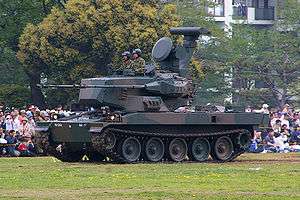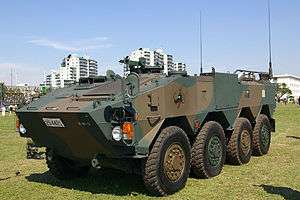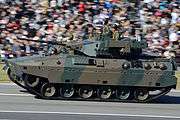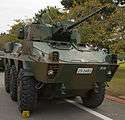Japan Ground Self-Defense Force
| Japan Ground Self-Defense Force | |
|---|---|
| 陸上自衛隊 | |
 Ensign of the Japan Ground Self-Defense Force | |
| Founded | 1 July 1954[1] |
| Country |
|
| Type | Army |
| Role | Land warfare |
| Size | 150,000 active personnel |
| Part of |
|
| Garrison/HQ | Ichigaya, Shinjuku, Tokyo, Japan |
| Colours | Red, White and Gold |
| March |
Review March (分列行進曲) |
| Website |
www |
| Commanders | |
| Commander-in-Chief | PM Shinzō Abe |
| Minister of Defense | Takeshi Iwaya |
| Chief of Staff, Joint Staff | Admiral Katsutoshi Kawano |
| Chief of the Ground Staff | General Kōji Yamazaki |
| Insignia | |
| Emblem of the Japan Ground Self-Defense Force |
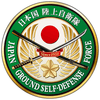 |
The Japan Ground Self-Defense Force (陸上自衛隊 Rikujō Jieitai), JGSDF, also referred to as the Japanese Army,[2] is the land-warfare branch of the Japan Self-Defense Forces, and is the de facto army of Japan. Created on July 1, 1954, it is the largest of the three services of the Japan Self-Defense Forces.
New military guidelines, announced in December 2010, direct the Japan Self-Defense Forces away from their Cold War focus on the Soviet Union to a new focus on China, especially in respect of the dispute over the Senkaku Islands. The JGSDF is chiefly tasked with maintaining internal security in Japan.
The JGSDF operates under the command of the chief of the ground staff, based in the city of Ichigaya, Shinjuku, Tokyo. The present chief of staff is General Koji Yamazaki (Japanese: 山崎 幸二). The JGSDF numbered around 150,000 soldiers in 2008.[3] As of 2010, the number remained the same at approximately 150,000 personnel.[4]
History
Japan accepted the Potsdam Declaration in 1945, and, in compliance with Article 9, the Imperial Japanese Army and Imperial Japanese Navy were dismantled. Both were replaced by the United States Armed Forces occupation force, which assumed responsibility for the external defense of Japan.
Despite MacArthur and the SCAP's strict insistence on Japan having no military or self defence by constitution, Japanese prime minister Hitoshi Ashida amended article 9 of the constitution to allow the creation of military forces in Japan which would operate under the name of self-defence forces. Which the ground, naval and air self defence forces all originate from. Rendering the occupations desire for a demilitarised Japan rather moot.[5]
Under the terms of the Treaty of Mutual Cooperation and Security between the United States and Japan, United States forces stationed in Japan were to deal with external aggression against Japan while Japanese forces, both ground and maritime, would deal with internal threats and natural disasters. Accordingly, in mid-1952, the National Police Reserve was expanded to 110,000 men and named the National Safety Forces.[6]
Japan continued to improve its defensive capabilities. On July 1, 1954, the National Security Board was reorganized as the Defense Agency, and the National Security Force was reorganized afterwards as the Japan Ground Self-Defense Force (Army), the Japan Maritime Self-Defense Force (Navy) and the Japan Air Self-Defense Force (Air force), with General Keizō Hayashi appointed as the first Chairman of Joint Staff Council—professional head of the three branches. The enabling legislation for this was the 1954 Self-Defense Forces Act [Act No. 165 of 1954].[1]
For a long period, the Japan Ground Self-Defense Force possessed a dubious ability to hold off a Soviet invasion of Hokkaido. Zbigniew Brzezinski observed in 1972 that it seemed optimized to fight ‘a Soviet invasion conducted on American patterns of a quarter of a century ago.[7] While the force is now an efficient army of around 150,000,[4] its apparent importance had, until recently, seemingly declined with the end of the Cold War, and attempts to reorient the forces as a whole to new post Cold War missions have been tangled in a series of internal political disputes.
In 2015, the Japanese Diet passes a law that allowed for the reinterpretation of Article 9 of the constitution. JSDF personnel train with the American forces in amphibious assault units designed to take outlying islands.[8]
Japan activated its first marine unit since World War Two on April 7, 2018. The marines of the Amphibious Rapid Deployment Brigade are trained to counter invaders from occupying Japanese islands along the edge of the East China Sea.[9]
Current deployment
Personnel
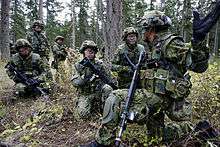
_Flag_-_Orient_Shield_2017_Opening_Ceremony.png)
In 1989, basic training for lower-secondary and upper-secondary academy graduates began in the training brigade and lasted approximately three months. Specialized enlisted and non-commissioned officer (NCO) candidate courses were available in branch schools and qualified NCOs could enter an eight-to-twelve-week officer candidate program. Senior NCOs and graduates of an eighty-week NCO pilot course were eligible to enter officer candidate schools, as were graduates of the National Defense Academy at Yokosuka and graduates of all four-year universities. Advanced technical, flight, medical and command and staff officer courses were also run by the JGSDF. Like the maritime and air forces, the JGSDF ran a youth cadet program offering technical training to lower-secondary school graduates below military age in return for a promise of enlistment.
Because of population density and urbanization on the Japanese islands, only limited areas are available for large-scale training, and, even in these areas, noise restrictions are extensive. The JGSDF has adapted to these conditions by conducting command post exercises, map manoeuvres, investing in simulators and other training programs, as well as conducting live fire exercises overseas at locations such as the Yakima Training Center in the United States.
The JGSDF has two reserve components: the rapid-reaction reserve component (即応予備自衛官制度) and the main reserve component (一般予備自衛官制度). Members of the rapid-reaction component train 30 days a year. Members of the main reserve train five days a year. As of December 2007, there were 8,425 members of the rapid-reaction reserve component and 22,404 members of the main reserve component.[10]
Equipment
Organization
Major Command
- Ground Component Command (陸上総隊 Rikujō-Sōtai) is headquartered in Asaka, Saitama Prefecture. It was reorganized from the Central Readiness Force on March 27, 2018. In wartime, it would take command of two to five armies.
Armies
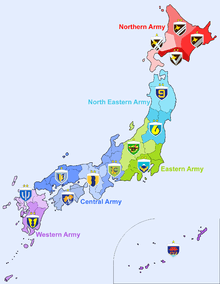
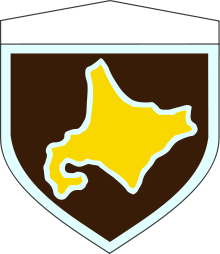

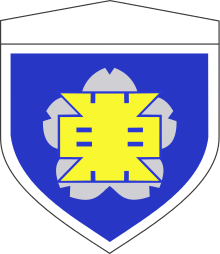


Division
JGSDF currently has nine active duty divisions (1 armored, 8 infantry)
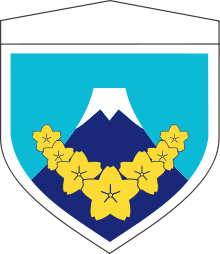
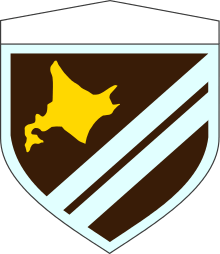



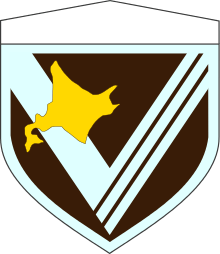
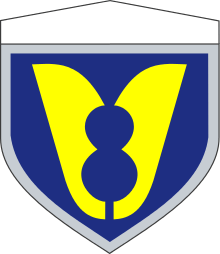

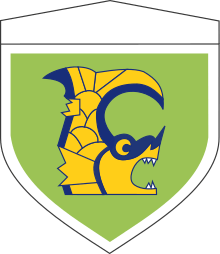
Brigade
JGSDF currently has 7 active brigades and one partially formed amphibious brigade
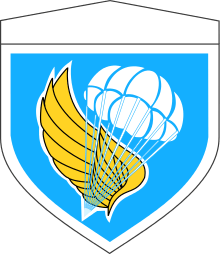
- 1st Artillery Brigade, at Camp Kita Chitose in Chitose, Hokkaido Prefecture
- 1st Helicopter Brigade, at Camp Kisarazu in Kisarazu, Chiba Prefecture
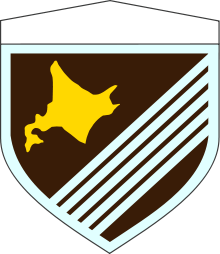
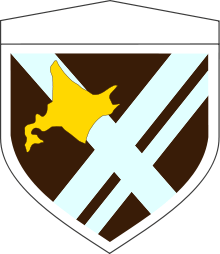
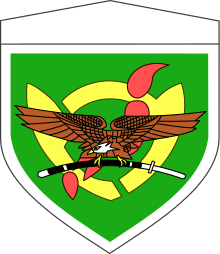

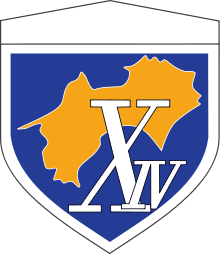
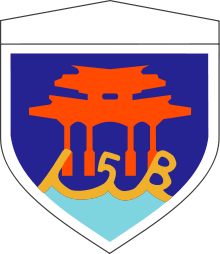
- Amphibious Rapid Deployment Brigade
Other units
- Other Units and Organizations
- Material Control Command
- Ground Research & Development Command
- Signal Brigade
- Military Police
- Military Intelligence Command
- Intelligence Security Command
- Ground Staff College
- Ground Officer Candidate School
- Others
.jpg)
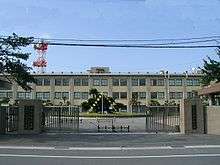
Tactical organization
The GSDF consists of the following tactical units:
- one armored division (7th),
- eight infantry divisions, each with three battalion-sized infantry regiments,
- six infantry brigades (5th Brigade, 11th Brigade, 12th Brigade, 13th Brigade, 14th Brigade, and 15th Brigade)
- one airborne brigade (1st Airborne Brigade),
- five combined (training) brigades,
- one artillery brigade,
- two air defense brigades,
- four engineer brigades,
- one helicopter brigade with twenty-four squadrons and two anti-tank helicopter platoons.
JGSDF divisions and brigades are combined arms units with infantry, armored, and artillery units, combat support units and logistical support units. They are regionally independent and permanent entities. The divisions strength varies from 6,000 to 9,000 personnel. The brigades are smaller with 3,000 to 4,000 personnel.
Ranks
Officers(幹部)
| Insignia | OF-9 General 統合幕僚長 および 陸上幕僚長 たる陸将 | OF-8 Lieutenant General 陸将 | OF-7 Major General 陸将補 |
OF-5 Colonel 1等陸佐 | OF-4 Lieutenant Colonel 2等陸佐 | OF-3 Major 3等陸佐 |
OF-2 Captain 1等陸尉 | OF-1 First Lieutenant 2等陸尉 | OF-1 Second Lieutenant 3等陸尉 |
|---|---|---|---|---|---|---|---|---|---|
| Type A (甲階級章) |
.svg.png) | .svg.png) | .svg.png) |
.svg.png) | .svg.png) | .svg.png) |
.svg.png) | .svg.png) | .svg.png) |
| Type B (乙階級章) |
.svg.png) | .svg.png) | .svg.png) |
.svg.png) | .svg.png) | .svg.png) |
.svg.png) | .svg.png) | .svg.png) |
| Miniature (略章) |
.svg.png) | .svg.png) | .svg.png) |
.svg.png) | .svg.png) | .svg.png) |
.svg.png) | .svg.png) | .svg.png) |
Warrant Officer & Enlisted(准尉および曹士)
| Insignia | OR-9 Warrant Officer 准陸尉 | OR-8 Sergeant Major 陸曹長 | OR-7 Master Sergeant 1等陸曹 | OR-6 Sergeant First Class 2等陸曹 | OR-5 Sergeant 3等陸曹 | OR-3 Leading Private 陸士長 | OR-2 Private First Class 1等陸士 | OR-1 Private 2等陸士 | OR-D Self Defence Official Cadet 自衛官候補生 |
|---|---|---|---|---|---|---|---|---|---|
| Type A (甲階級章) |
.svg.png) | .svg.png) | .svg.png) | .svg.png) | .svg.png) |
.svg.png) | .svg.png) | ||
| Type B (乙階級章) |
.svg.png) | .svg.png) | .svg.png) | .svg.png) | .svg.png) |
.svg.png) | .svg.png) | .svg.png) | .svg.png) |
| Miniature (略章) |
.svg.png) | .svg.png) | .svg.png) | .svg.png) | .svg.png) |
.svg.png) | .svg.png) | No insignia |
See also
References
- 1 2 "Japan Self-Defense Force | Defending Japan". Defendingjapan.wordpress.com. Retrieved 2014-08-03.
- ↑ https://www.militaryfactory.com/modern-armor/japan-ground-self-defense-force.asp
- ↑ IISS Military Balance 2008, Routledge, London, 2008, p.384
- 1 2 IISS 2010, pp. 408–411
- ↑ Fumiko Sasaki (26 July 2012). Nationalism, Political Realism and Democracy in Japan: The thought of Masao Maruyama. Routledge. p. 136. ISBN 978-1-136-31378-3. Retrieved 24 May 2013.
- ↑ Frank Kowalski, An Inoffensive Rearmament: The Making of the Postwar Japanese Army, Naval Institute Press, 2014, p.72
- ↑ Zbigniew Brzezinski, The Fragile Blossom (Harper, 1972) p.95, in James H. Buck, ‘The Japanese Military in the 1980s, in James H. Buck (ed.), The Modern Japanese Military System, Sage Publications, Beverly Hills/London, 1975, p.220
- ↑ An article in The Economist dated Nov 20, 2017
- ↑ Kubo, Nobuhiro Japan activates first marines since WW2 to bolster defenses against China. April 7, 2018. Reuters. Retrieved August 2, 2018
- ↑ Archived March 9, 2010, at the Wayback Machine.
External links
| Wikimedia Commons has media related to Japan Ground Self-Defense Force. |
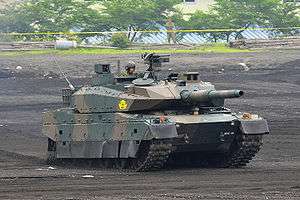
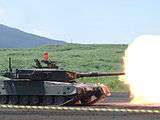
_left_front_view_at_Camp_Nihonbara_October_1%2C_2017_02.jpg)
